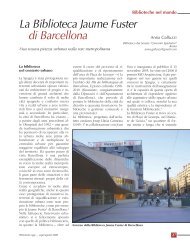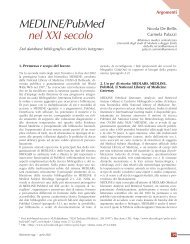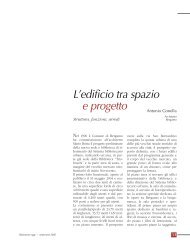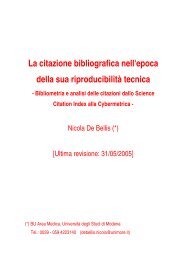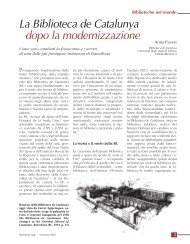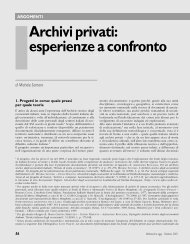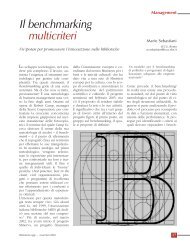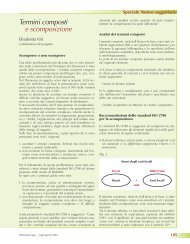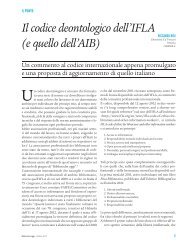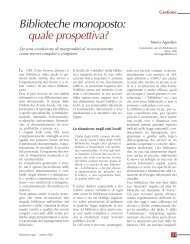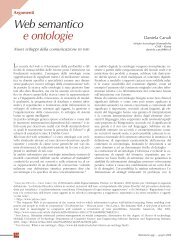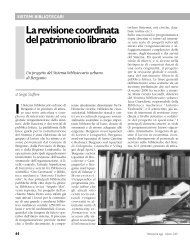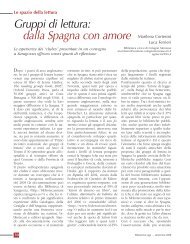L'indice di Hirsch (h-index) e altri indici citazionali ... - Biblioteche oggi
L'indice di Hirsch (h-index) e altri indici citazionali ... - Biblioteche oggi
L'indice di Hirsch (h-index) e altri indici citazionali ... - Biblioteche oggi
You also want an ePaper? Increase the reach of your titles
YUMPU automatically turns print PDFs into web optimized ePapers that Google loves.
Valutazione<br />
cui risultato ha <strong>di</strong>mostrato una percentuale<br />
maggiore <strong>di</strong> citazioni ricevute<br />
da riviste presenti anche online, in<br />
misura pari a circa il 300%. Lo stu<strong>di</strong>o<br />
è sintetizzato in STEVE LAWRENCE, Free<br />
online availability substantially increases<br />
a paper’s impact, “Nature”, (31<br />
May 2001), 411, p. 521.<br />
9 HELEN GEORGAS – JOHN CULLARS, A citation<br />
study of the characteristics of the<br />
linguistics literature, “College & Research<br />
Libraries”, 66 (2005), 6, p. 496-<br />
515, oppure .<br />
10 JENNIFER E. KNIEVEL – CHARLENE KELL-<br />
SEY, Citation analysis for collection development:<br />
a comparative study of<br />
eight humanities fields, “Library Quarterly”,<br />
75 (2005), 2, p. 142-168.<br />
11 THOMAS E. NISONGER, Citation autobiography:<br />
an investigation of ISI<br />
database coverage in determining author<br />
citedness, “College & Research Libraries”,<br />
65 (2004), 2, p. 152-163, oppure<br />
. L’articolo presenta nel<br />
dettaglio la metodologia <strong>di</strong> analisi e i<br />
risultati ottenuti nella ricerca <strong>di</strong> citazioni<br />
dei lavori dello stesso Nisonger,<br />
autore ben noto e prolifico soprattutto<br />
sul tema della gestione delle raccolte.<br />
12 ALESSANDRO FIGÀ-TALAMANCA, L’“impact<br />
factor” nella valutazione della ricerca<br />
e nello sviluppo dell’e<strong>di</strong>toria scientifica,<br />
intervento al IV Seminario SINM, , 2000. L’articolo è <strong>di</strong> e-<br />
stremo interesse poiché, oltre alle considerazioni<br />
critiche <strong>di</strong> carattere generale,<br />
analizza “dall’interno” il caso della<br />
matematica, <strong>di</strong>sciplina <strong>di</strong> cui Figà-Talamanca<br />
è docente all’Università <strong>di</strong> Roma<br />
“La Sapienza”, supportando l’analisi<br />
con esempi specifici.<br />
13 È ancora pesantemente il caso delle<br />
riviste del settore HSS, particolarmente<br />
nel contesto italiano, come <strong>di</strong>mostra<br />
l’analisi <strong>di</strong> GIUSEPPE VITIELLO, Il<br />
mercato delle riviste in Scienze umane<br />
e sociali in Italia, “<strong>Biblioteche</strong> <strong>oggi</strong>”,<br />
23 (2005), 1, p. 56-66.<br />
14 Si vedano i due esempi citati: JENNIFER<br />
E. KNIEVEL – CHA RLENE KELLSEY, Citation<br />
analysis for collection development…,<br />
cit., e JURIS DILEVKO – KEREN DALI, Improving<br />
collection development…, cit.<br />
15 ALESSANDRO FIGÀ-TALAMANCA, L’“impact<br />
factor” nella valutazione della ricerca...,<br />
cit.<br />
16 J. PARKER LADWIG – ANDREW J. SOMMESE,<br />
Using cited half-life to adjust download<br />
statistics, “College & Research<br />
Libraries”, 66 (2005), 6, p. 527-542,<br />
oppure .<br />
17 Per quanto riguarda le caratteristiche,<br />
le potenzialità e i limiti delle statistiche<br />
d’uso delle risorse elettroniche,<br />
si rimanda a: ROSSANA MORRIELLO<br />
– ANNA ORTIGARI, Statistiche d’uso delle<br />
risorse elettroniche per la valutazione<br />
delle raccolte in un contesto <strong>di</strong> cooperazione,<br />
in Gestione delle raccolte<br />
e cooperazione nella biblioteca ibrida,<br />
a cura <strong>di</strong> Nicola Benvenuti e Rossana<br />
Morriello, Firenze, Firenze University<br />
Press, 2006, p. 37-56.<br />
18 ENDRE SZÁVA-KOVÁTS, Unfounded attribution<br />
of the “half-life” <strong>index</strong>-number<br />
of literature obsolescence to Burton<br />
and Kebler: a literature science<br />
study, “Journal of the American Society<br />
for Information Science and Technology,<br />
53 (2002), 13, p. 1098-1105.<br />
19 MING-YUEH TSAY, Library journal use<br />
and citation half-life in me<strong>di</strong>cal science,<br />
“Journal of the American Society for<br />
Information Science”, 49 (1998), 4, p.<br />
1283-1292. Altri stu<strong>di</strong> comparativi dei<br />
dati ISI con l’uso locale sono riportati<br />
in questo e in <strong>altri</strong> articoli già citati.<br />
20 J. PARKER LADWIG – ANDREW J. SOMMESE,<br />
Using cited half-life to adjust download<br />
statistics, cit.<br />
21 BENOÎT GODIN, On the origins of bibliometrics,<br />
“Scientometrics”, 68 (2006),<br />
1, p. 109-133.<br />
22 J.H. HIRSCH, An <strong>index</strong> to quantify an<br />
in<strong>di</strong>vidual’s scientific research output,<br />
“Procee<strong>di</strong>ngs of the National Academy<br />
of Science of the United States of<br />
America”, 102 (2005), 46, p. 16569-<br />
16572: 16569.<br />
23 Anche se incentrato su <strong>altri</strong> aspetti,<br />
è interessante il recente articolo in cui<br />
vengono comparati i tre prodotti: EZIO<br />
TARANTINO, Troppo o troppo poco Web<br />
of Science, Scopus, Google Scholar: tre<br />
database a confronto (un caso <strong>di</strong> stu<strong>di</strong>o),<br />
“Bollettino AIB”, 46 (2006), 1/2,<br />
oppure .<br />
24 Oltre allo stesso articolo <strong>di</strong> <strong>Hirsch</strong>, si<br />
possono vedere a riguardo: LEO EGGHE –<br />
RONALD ROUSSEAU, An infometric model<br />
for the <strong>Hirsch</strong>-<strong>index</strong>, “Scientometrics”, 69<br />
(2006), 1, p. 121-129; WOLFGANG GLÄNZEL,<br />
On the h-<strong>index</strong>: a mathematical approach<br />
to a new measure of publication<br />
activity and citation impact, “Scientometrics”,<br />
67 (2006), 2, p. 315-321.<br />
25 GAD SAAD, Exploring the h-<strong>index</strong> at<br />
the author and journal levels using bibliometric<br />
data of productive consumer<br />
scholars and business-related<br />
journals respectively, “Scientometrics”,<br />
69 (2006), 1, p. 117-120. Si veda anche:<br />
LUTZ BORNMANN – HANS-DIETER DANIEL,<br />
Does the h-<strong>index</strong> for ranking of scientists<br />
really work, “Scientometrics”, 65<br />
(2005), 3, p. 391-392.<br />
26 MICHAEL G. BANKS, An extension of<br />
the <strong>Hirsch</strong> <strong>index</strong>: <strong>index</strong>ing scientific<br />
topics and compounds, “Scientometrics”,<br />
69 (2006), 1, p. 161-168.<br />
27 CLINT D. KELLY – MICHAEL D. JENNIONS,<br />
The h-<strong>index</strong> and career assessment by<br />
numbers, “Trends in Ecology and<br />
Evolution, 21 (2006), 4, p. 167-170.<br />
28 LEO EGGHE, Theory and practise of the<br />
g-<strong>index</strong>, “Scientometrics”, 69 (2006), 1,<br />
p. 131-152.<br />
Abstract<br />
The impact factor, which originally<br />
was developed to measure<br />
the citation impact of journals,<br />
is currently used for evaluating<br />
researchers despite the many<br />
problems that this use involves.<br />
To overcome those problems,<br />
recently J.H <strong>Hirsch</strong> proposed a<br />
new <strong>index</strong>, known as the h-<strong>index</strong><br />
or <strong>Hirsch</strong> <strong>index</strong>, to be adopted<br />
in evaluating researchers and<br />
research output. Anyway, some<br />
weak points have been found<br />
also in the h-<strong>index</strong> and solutions<br />
have been proposed.<br />
Those and other citation indeces,<br />
like the imme<strong>di</strong>acy <strong>index</strong> and the<br />
cited half-life <strong>index</strong>, are also used<br />
in collection development.<br />
In this article, new and old citation<br />
indeces are <strong>di</strong>scussed as for their<br />
use both in collection development<br />
and in evaluating research.<br />
32<br />
<strong>Biblioteche</strong> <strong>oggi</strong> – gennaio-febbraio 2007



